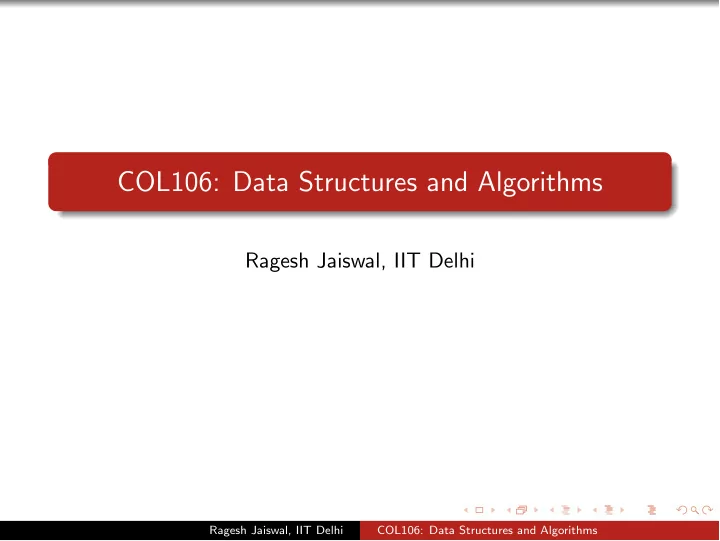

COL106: Data Structures and Algorithms Ragesh Jaiswal, IIT Delhi Ragesh Jaiswal, IIT Delhi COL106: Data Structures and Algorithms
Greedy Algorithms: Job Scheduling Ragesh Jaiswal, IIT Delhi COL106: Data Structures and Algorithms
Greedy Algorithms Job scheduling Problem Job scheduling: You are given n jobs and you are supposed to schedule these jobs on a machine. Each job i consists of a duration T ( i ) and a deadline D ( i ). The lateness of a job w.r.t. a schedule is defined as max(0 , F ( i ) − D ( i )), where F ( i ) is the finishing time of job i as per the schedule. The goal is to minimise the maximum lateness. Ragesh Jaiswal, IIT Delhi COL106: Data Structures and Algorithms
Greedy Algorithms Job scheduling Problem Job scheduling: You are given n jobs and you are supposed to schedule these jobs on a machine. Each job i consists of a duration T ( i ) and a deadline D ( i ). The lateness of a job w.r.t. a schedule is defined as max(0 , F ( i ) − D ( i )), where F ( i ) is the finishing time of job i as per the schedule. The goal is to minimise the maximum lateness. Greedy strategies Smallest jobs first. Ragesh Jaiswal, IIT Delhi COL106: Data Structures and Algorithms
Greedy Algorithms Job scheduling Problem Job scheduling: You are given n jobs and you are supposed to schedule these jobs on a machine. Each job i consists of a duration T ( i ) and a deadline D ( i ). The lateness of a job w.r.t. a schedule is defined as max(0 , F ( i ) − D ( i )), where F ( i ) is the finishing time of job i as per the schedule. The goal is to minimise the maximum lateness. Greedy strategies Smallest jobs first. Earliest deadline first. Algorithm GreedyJobSchedule - Sort the jobs in non-decreasing order of deadlines and schedule the jobs on the machine in this order. Ragesh Jaiswal, IIT Delhi COL106: Data Structures and Algorithms
Greedy Algorithms Job scheduling Algorithm GreedyJobSchedule - Sort the jobs in non-decreasing order of deadlines and schedule the jobs on the machine in this order. Claim 1: There is an optimal schedule with no idle time (time when the machine is idle). Definition A schedule is said to have inversion if there are a pair of jobs ( i , j ) such that 1 D ( i ) < D ( j ), and 2 Job j is performed before job i as per the schedule. Claim 2: There is an optimal schedule with no idle time and no inversion. Ragesh Jaiswal, IIT Delhi COL106: Data Structures and Algorithms
Greedy Algorithms Job scheduling Claim 2: There is an optimal schedule with no idle time and no inversion. Proof sketch of Claim 2 Consider an optimal schedule O . First, if there is any idle time, we obtain another optimal schedule O 1 without the idle time. Suppose O 1 has inversions. Consider one such inversion ( i , j ). Claim 2.1: If an inversion exists, then there exists a pair of adjacently scheduled jobs ( m , n ) such that the schedule has an inversion w.r.t. ( m , n ). Ragesh Jaiswal, IIT Delhi COL106: Data Structures and Algorithms
Greedy Algorithms Job scheduling Claim 2: There is an optimal schedule with no idle time and no inversion. Proof sketch of Claim 2 Consider an optimal schedule O . First, if there is any idle time, we obtain another optimal schedule O 1 without the idle time. Suppose O 1 has inversions. Consider one such inversion ( i , j ). Claim 2.1: If an inversion exists, then there exists a pair of adjacently scheduled jobs ( m , n ) such that the schedule has an inversion w.r.t. ( m , n ). Claim 2.2: If a schedule has an inversion w.r.t. adjacently scheduled jobs ( m , n ), then exchanging m and n does not increase the maximum lateness. Ragesh Jaiswal, IIT Delhi COL106: Data Structures and Algorithms
End Ragesh Jaiswal, IIT Delhi COL106: Data Structures and Algorithms
Recommend
More recommend